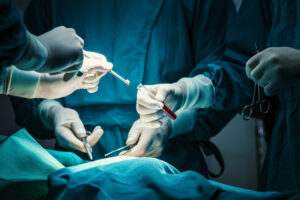VENTRAL HERNIA REPAIR
CONTACT US TODAY!
Submit your information below and speak with a representative.
VENTRAL HERNIA REPAIR
CONTACT US TODAY!
Submit your information below and speak with a representative.
Ventral Hernia Repair
Ventral hernia repair is the process to treat the fatty tissue that has pushed through the abdominal wall in one simple procedure.
What is a Ventral Hernia?
A ventral hernia originates from a group of fatty tissue that breaks through a weak spot in the abdominal wall. They can happen at any part of the abdomen, but are most common where the walls of the abdomen have been weakened or thinned. Weight Loss Los Angeles has skilled surgeons who can repair a ventral and seal hernias so that the patient in question has a comfortable and personalized experience.
Incisional Ventral Hernia – occurs where a past surgery or cut into the abdomen has been made.
Incarcerated Ventral Hernia – occurs when the intestines are captured in the abdominal wall and the blood flow to the intestines is cut off. This is a fatal condition and can require immediate emergency surgery.
Strangulation Ventral Hernia – when the lump is large enough to block your intestines and block the blood flow. This causes the intestine to decay and die. This requires immediate surgery to save the intestine.

Do You Have a Ventral Hernia?
If you have a hernia, you probably know, but might require a physical examination, but there are many different kinds of hernias that have different effects on the body. The key indicators of a ventral hernia are:
- A soft lump in the area where you most recently had surgery – this lump can include pain such as burning or aching but it isn’t always present.
- A stabbing pain or uncomfortable sensation in your abdomen whenever you cough, sneeze, laugh, or lift something.
- Constipation and cramping due to obstruction of the intestines.
- Nausea and vomiting are rare and extreme cases. If you’re experiencing this, seek emergency medical attention immediately.
Most diagnoses are done following observations of your medical history and a physical exam by a WLLA professional. This goes in correlation with the explanation you give the physician. Be sure to properly elaborate on all of the complications and concerns you’ve had regarding the hernia and your surgical history. The equipment used to properly analyze the hernia ranges across X-Rays, Ultrasounds, CT scans, MRI scans, and blood tests. There are determining risk factors that may increase your chances of having a ventral hernia:
- Pregnancy – if you have had multiple pregnancies, it can weaken the abdominal walls over time
- Obesity (BMI over 30) – extra fat makes more tissue and also minimizes the strength of your abdominal walls
- Chronic hernias – if you’ve had a hernia sealed before, it’s possible for another to appear either in the same place or somewhere else
- Straining – heavy lifting, coughing, laughing, sneezing, and other methods of straining your muscles can force pressure onto your abdominal walls.
These hernias are most common in people who have had surgery in the past and is the reason a ventral hernia is also known as an incisional hernia.
What is Ventral Hernia Repair?
This is a procedure that involves a surgical incision in the abdomen, putting all fatty tissue back in line with the intestines, and then sealing that part of the abdomen to make it stronger than it was before. Because it is a surgical procedure that involves cutting into the abdomen, it requires sedation whether it be full anesthesia or partial sedation where you’re still awake but feel no pain, this is a minimally invasive procedure. Your method of sedation depends on the severity of your hernia, your medical history, and your preferences. WLLA ensures that your situation and thoughts are taken seriously before operating. The surgeon will reinforce your abdominal walls with stitches and sutures so you are less at risk for another hernia in the future, but this isn’t always guaranteed.
Laparoscopic Ventral Hernia Repair
This method accomplishes the same goal but with fewer and smaller incisions. A laparoscope is a surgical camera on the end of an elongated tool that is slid into your body through one of the small incisions. From there, the surgeon is able to operate over a screen. This procedure is clean and more efficient, causing less damage, creating fewer scars, and reducing the possibility of infection during the healing period.
Benefits of a Ventral Hernia Repair
For more severe situations, it can be the end of chronic pain and discomfort. For most people, it is a cosmetic improvement and eliminates the possibility of what could’ve escalated to a bigger issue.
Risks of a Ventral Hernia Repair
Negative effects of this surgery are rare and depend on the severity of your operation. Some procedures can leave a large, permanent scar where the incision was made depending on the size of the hernia and method used. All surgical procedures run the risk of infections because of the way this procedure is done. Without proper care, you run the risk of infecting vital organs, nerves, and vessels connected to systems such as digestive, respiratory, digestive and others. The possibility of blood clots also exists depending on your existing health conditions.
Preparing for a Ventral Hernia Repair
Your doctor will give you specific instructions on what needs to be done leading up to the procedure. Everyone is different and their procedure parameters determine how you will be requested to prepare. If you are being administered anesthesia then you may be requested not to eat up to 12 hours prior to the operation. Be sure that you are comfortable with your surgeon. Inform them of your medical history and medication. You may be asked to stop taking medications, such as blood thinners and pain relievers for anti-inflammatories, depending on the extent of your operation and your standing health conditions.
After a Ventral Hernia Repair
If you will be under anesthesia, you will need someone to drive you home following the procedure. Not all operations require overnight stays in a hospital. Into the healing period, you will have a follow-up appointment with your doctor to monitor your progress, avoiding the possibility of infection or blood clots. There is little chance for a hernia to form again in the future, but it is not is a possibility. You will have to be careful with lifting and other forms of straining that may damage where the incisions are.

CALCULATE YOUR BMI
BMI is a measurement of your body fat based on your height and weight. Knowing your BMI can help you understand whether you fall into the categories of Overweight or Obese.
CONTACT US TO SPEAK DIRECTLY WITH A REPRESENTATIVE.
BMI CALCULATOR CHART
| BMI | WEIGHT STATUS |
|---|---|
| Below 18.5 | Underweight |
| 18.5 – 24.9 | Normal |
| 25.0 – 29.9 | Overweight |
| 30.0 and Above | Obese |

Ask Us A Question
(213) 358-2323
Here at WLLA, we are prepared to assist you on your journey health and beauty. Take the first step in living your life with confidence by contacting us and scheduling an appointment. By the end of your appointment you will gain a treatment plan customly made for you. Begin your journey by calling us today.
CONTACT US TODAY!
Submit your information below and speak with a representative.



